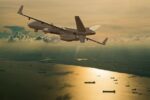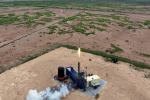Ukraine has unveiled a new generation of its indigenous “Sea Baby” unmanned surface vessels (USVs), marking a significant evolution in its asymmetric maritime warfare capabilities. The upgraded naval drones are designed to extend operational reach and deliver heavier payloads against Russian targets in the contested waters of the Black Sea.
New Capabilities Signal Strategic Shift in Ukraine’s Naval Doctrine
The upgraded Sea Baby USVs represent a leap forward from earlier models used by Ukraine’s Security Service (SBU) and Defence Intelligence Directorate (GUR). According to recent statements by SBU chief Vasyl Maliuk and confirmed by open-source imagery and video footage released on October 25, 2025, the new platform boasts substantial improvements in range—up to 1,000 km—and can carry up to 850 kg of explosives. This is a notable increase from earlier variants that carried approximately 300–450 kg over shorter distances.
These enhancements enable the drones to strike deeper into Russian-controlled maritime zones and coastal infrastructure. Maliuk emphasized that these systems are not only weapons but also platforms for intelligence gathering and special operations support. The modular design reportedly allows for integration of ISR sensors or light anti-armor weapons like the Ukrainian-made Stugna-P ATGM.
Operational History: From Covert Raids to Strategic Disruption
The Sea Baby has already proven itself as a potent tool in Ukraine’s naval campaign. Since mid-2023, these USVs have been used in multiple high-profile attacks including:
- The July 2023 attack on the Crimean Bridge (Kerch Strait), damaging key logistics infrastructure.
- Repeated strikes on Russian Navy vessels near Sevastopol using kamikaze tactics.
- Targeted assaults on oil tankers and port facilities supporting Russia’s war logistics.
These operations have forced Russia’s Black Sea Fleet into a more defensive posture. Open-source intelligence indicates that many high-value assets have been relocated from Sevastopol to Novorossiysk or further east due to persistent USV threats. The psychological impact is also significant—Russian commanders now face constant uncertainty about potential drone incursions along hundreds of kilometers of coastline.
Design Evolution: Range Extension and Payload Flexibility
The latest iteration of the Sea Baby appears larger than its predecessors and features improved hydrodynamics for extended endurance. While exact specifications remain classified, visual analysis suggests:
- A length exceeding 5 meters with low radar cross-section shaping.
- A probable hybrid propulsion system enabling stealthy loitering followed by high-speed terminal approach (>70 km/h).
- An EO/IR sensor turret mounted forward for navigation and target acquisition.
The payload bay is modular—capable of housing high-explosive warheads or alternative mission kits such as electronic warfare jammers or SIGINT receivers. Some reports suggest trials with onboard loitering munitions or FPV drone launchers are underway. This would allow multi-axis attacks combining surface strike with aerial saturation.
Tactical Implications for Russia’s Maritime Posture
The proliferation of long-range USVs like the upgraded Sea Baby complicates traditional naval defense paradigms. Unlike crewed fast attack craft or missile boats—which require extensive training and logistic support—these drones can be mass-produced at lower cost using commercial off-the-shelf components (COTS). Their expendability makes them ideal for saturating defenses or probing weak points along contested littorals.
Russia has responded by deploying more counter-USV measures around key ports—including booms, nets, acoustic sensors, and small-caliber autocannons mounted on patrol boats. However, these static defenses are vulnerable to saturation or deception tactics. Furthermore, Ukrainian operators have demonstrated increasing sophistication in timing attacks during poor visibility conditions or exploiting gaps between radar coverage zones.
Industry Support and Future Development Pathways
While officially developed under SBU auspices with support from GUR units, several Ukrainian defense tech startups are believed to be involved in prototyping components—from propulsion systems to AI-based navigation algorithms. Open-source tracking suggests involvement from companies previously linked with FPV drone production lines now repurposed for maritime applications.
Future variants may incorporate satellite uplinks via Starlink or other secure mesh networks for beyond-line-of-sight operation without GPS dependency—a critical resilience feature given Russia’s increasing use of GNSS jamming across southern Ukraine and Crimea. Integration with airborne ISR assets such as Bayraktar TB2s could also enable real-time targeting updates mid-mission.
A Model for Asymmetric Naval Warfare Beyond Ukraine
The success of platforms like the Sea Baby may influence other small-to-mid-sized navies seeking cost-effective deterrence against larger adversaries. By combining autonomy with modular lethality at scale, Ukraine has demonstrated how non-traditional actors can contest sea control without blue-water fleets.
Nations facing similar constraints—such as Taiwan vis-à-vis China or Baltic states facing Russian threats—are likely studying this model closely. Western defense planners too may need to rethink force protection doctrines around ports and amphibious operations under threat from swarming autonomous systems launched from land-based hideouts or civilian-looking vessels offshore.










